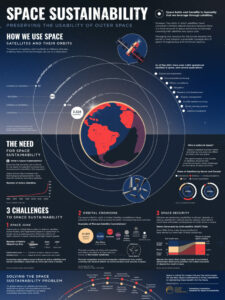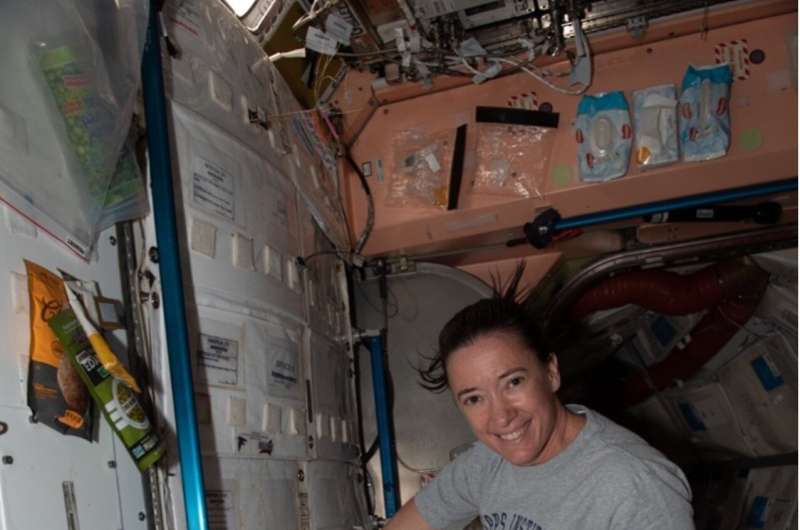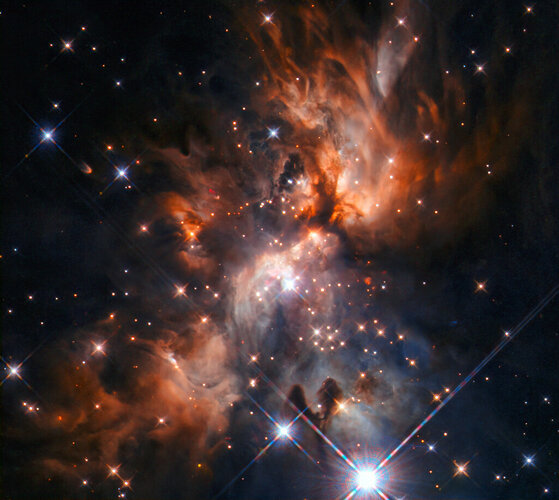Investing recovery and resilience funds in space projects
Friday, 17 December 2021 16:38
Green and digital transition in Europe will benefit from ESA expertise that supports national plans for investing recovery and resilience funds in space projects.
At the 303rd ESA Council meeting in Paris on 15 December 2021, ESA Member States took the decision to further the role of ESA as provider of expertise in support of national space plans, in particular in order to accompany the investment of Italian recovery and resilience funds in space programmes.
Op-ed | A global model for tackling space sustainability and safety
Friday, 17 December 2021 16:01
While international agreements such as the Outer Space Treaty and the Registration Convention take steps to protect near space, no single global body is responsible for ensuring the long-term sustainability and safety of this precious resource.
Paving the way to thriving in space
Friday, 17 December 2021 15:50
In late December, SpaceX-24 will deliver a payload to the International Space Station. Three new experiments that will help scientists better understand specific biological and physical phenomena will be on board.
"It's really exciting when we get to conduct new investigations aboard the Space Station," said Dr. Craig Kundrot, Director of NASA's Biological and Physical Sciences Division. "What these three experiments have in common is each will contribute fundamental scientific insights that will both enable our astronauts to thrive on their future long-range missions and provide tangible benefits to people on Earth."
Growing plants in harsh conditions:
The Plant RNA Regulation Redux in Multi Variable Platform (MVP-Plant-01) experiment will profile and monitor a plant's shoot and root development under microgravity conditions. The results of this experiment will help scientists better understand the molecular mechanisms and regulatory networks behind how plants sense and adapt to environmental changes. Ultimately, the findings could help scientists design plants that will be able to withstand adverse environmental conditions, both during long spaceflights and here on Earth.
Malaysia outlines national space blueprint with focus on remote-sensing satellite development
Friday, 17 December 2021 13:54
During a Dec. 13 parliamentary hearing, a deputy minister shared the latest update on the “Malaysia Space Exploration 2030” blueprint being fleshed out by Malaysia’s Ministry of Science, Technology and Innovation.
Year in images 2021
Friday, 17 December 2021 13:22
Year in images 2021
Our year through the lens: a selection of our favourite images for 2021
China’s new rocket for crewed moon missions to launch around 2026
Friday, 17 December 2021 11:34
A new heavy-lift rocket designed to be capable of sending Chinese astronauts to the moon could have its first flight in 2026, according to a senior engineer.
Press briefing Webb Telescope
Friday, 17 December 2021 10:00 Video:
00:45:03
Video:
00:45:03
Replay of the 16 December 2021 online press briefing about the James Webb Space Telescope.
Speakers:
- Günther Hasinger, ESA Director of Science
- Daniel Neuenschwander, ESA Director of Space Transportations
- Thomas Zurbuchen, NASA’s Associate Administrator for science
- Antonella Nota, ESA Webb Project Scientist
- Gillian Wright, European Principal Investigator for the MIRI instrument
Developed and constructed over more than 30 years, Webb is a remarkable feat of engineering and technology – with the largest astronomical mirror ever flown in space, sophisticated new scientific instruments, and a sunshield the size of a tennis court.
Webb is designed to answer outstanding questions about the
Earth from Space: Kourou, French Guiana
Friday, 17 December 2021 08:00
Ahead of the upcoming Ariane 5 launch of the James Webb Space Telescope, the Copernicus Sentinel-2 mission takes us over Kourou – home to Europe’s Spaceport in French Guiana, an overseas department of France.
DiCaprio and Lawrence big up science in doomsday comedy
Friday, 17 December 2021 07:10 For Hollywood A-listers Leonardo DiCaprio and Jennifer Lawrence, their new end-of-the-world comedy was a chance to send a little respect back to scientists.
In "Don't Look Up", released on December 24 on Netflix, they play two astronomers who discover a comet will wipe out life on Earth within six months, but then try in vain to get politicians and the media to take the threat seriously.
For Hollywood A-listers Leonardo DiCaprio and Jennifer Lawrence, their new end-of-the-world comedy was a chance to send a little respect back to scientists.
In "Don't Look Up", released on December 24 on Netflix, they play two astronomers who discover a comet will wipe out life on Earth within six months, but then try in vain to get politicians and the media to take the threat seriously. Launch of GeeSAT commercial satellites fails
Friday, 17 December 2021 04:49 The launch of a pair of GeeSAT commercial satellites, carried by a Kuaizhou-1A carrier rocket, was unsuccessful, the launch center said in a statement Wednesday.
Abnormal performance was detected during the flight of the rocket, which lifted off from the Jiuquan Satellite Launch Center in northwest China at 10 a.m. (Beijing Time).
The cause of the failure is under investigation, acco
The launch of a pair of GeeSAT commercial satellites, carried by a Kuaizhou-1A carrier rocket, was unsuccessful, the launch center said in a statement Wednesday.
Abnormal performance was detected during the flight of the rocket, which lifted off from the Jiuquan Satellite Launch Center in northwest China at 10 a.m. (Beijing Time).
The cause of the failure is under investigation, acco NASA Completes Upper Part of Artemis II Core Stage
Friday, 17 December 2021 04:49 NASA has completed assembly of the upper, or forward, part of the core stage for the Space Launch System (SLS) rocket that will send the Artemis II crew on their lunar mission. Boeing, the lead core stage contractor, completed joining the forward part of the rocket, and then lifted it out of the assembly structure at NASA's Michoud Assembly Facility in New Orleans.
To construct this part o
NASA has completed assembly of the upper, or forward, part of the core stage for the Space Launch System (SLS) rocket that will send the Artemis II crew on their lunar mission. Boeing, the lead core stage contractor, completed joining the forward part of the rocket, and then lifted it out of the assembly structure at NASA's Michoud Assembly Facility in New Orleans.
To construct this part o NASA 'Fires Up' Artemis RS-25 Rocket Engines with New Components
Friday, 17 December 2021 04:49 NASA conducted a successful full-duration test Dec. 15 to begin a new series of testing for state-of-the-art RS-25 engines to help power the agency's Space Launch System (SLS), America's new deep-space rocket, on future missions to the Moon and Mars.
The first hot fire of the new series was conducted for a full-duration 500 seconds on the Fred Haise Test Stand (formerly A-1 Test Stand) at
NASA conducted a successful full-duration test Dec. 15 to begin a new series of testing for state-of-the-art RS-25 engines to help power the agency's Space Launch System (SLS), America's new deep-space rocket, on future missions to the Moon and Mars.
The first hot fire of the new series was conducted for a full-duration 500 seconds on the Fred Haise Test Stand (formerly A-1 Test Stand) at NASA's Perseverance Mars Rover Makes Surprising Discoveries
Friday, 17 December 2021 04:49 Scientists with NASA's Perseverance Mars rover mission have discovered that the bedrock their six-wheeled explorer has been driving on since landing in February likely formed from red-hot magma. The discovery has implications for understanding and accurately dating critical events in the history of Jezero Crater - as well as the rest of the planet.
The team has also concluded that rocks in
Scientists with NASA's Perseverance Mars rover mission have discovered that the bedrock their six-wheeled explorer has been driving on since landing in February likely formed from red-hot magma. The discovery has implications for understanding and accurately dating critical events in the history of Jezero Crater - as well as the rest of the planet.
The team has also concluded that rocks in Locked in stone: Research may answer the question of Mars' missing water
Friday, 17 December 2021 04:49 Rivers and streams once flowed across the surface of Mars, etching channels still evident on the planet's surface today. Water in lakes once lapped ancient shores.
All told, the geological evidence adds up to an ocean's worth of water, noted Geological Sciences and Environmental Studies Professor David Jenkins. But today, Mars' red sands appear bone-dry. Where did all that water go?
Rivers and streams once flowed across the surface of Mars, etching channels still evident on the planet's surface today. Water in lakes once lapped ancient shores.
All told, the geological evidence adds up to an ocean's worth of water, noted Geological Sciences and Environmental Studies Professor David Jenkins. But today, Mars' red sands appear bone-dry. Where did all that water go? 
